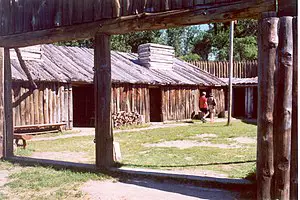Fort Mandan
The Lewis and Clark expedition started looking for a place to build a winter shelter, and by early November of 1804, they met two friendly Native Indian tribes that would help them.
The two tribes were the Mandan and Minitari that lived in what is modern-day Washburn, North Dakota.
The expedition made plans to set up their camp near the Missouri River banks and decided to start to build a fort that would be their home during the winter months.
- It took all of the group only about four weeks to build what they called “Fort Mandan,” which was a triangularly-shaped structure that was surrounded by 16-foot pickets. Inside it held storage rooms and living quarters. The 16-foot pickets were set up as protection against some of the hostile Native Indians that they had come across. Members of the Sioux tribe had been particularly bad, but they never attacked the fort. They named their fort after the Native tribe that had been kind and helpful.
- All of the men in the Corps devoted the next months at Fort Mandan, making canoes, hunting, creating ropes and leather clothing and moccasins. William Clark devoted his time to the preparation of some of the new maps. Clark kept an on-going journal and listed the men in good health at this time.
- The expedition crew maintained a good attitude during the month at Fort Mandan, and they celebrated their second Christmas and New Year’s inside the fort. The weather that year was unusually cold and has been called the “little ice age.” Unlike today where the weather is considerably warmer, in 1805, it was common for the Missouri River to completely freeze over. The high strong winds pushed the ever-growing snowdrifts, and although life was harsh during that time, the men were in unusually good spirits.
- In early February, Clark went with his men to hunt on a thirty mile, nine-day hike. He wanted to see what it was like to travel along a river that was frozen. On the second day of his trip, Clark broke through the Ice, getting his legs and feet wet. This was a dangerous thing in freezing weather. He began complaining on the third day that walking on all of the Ice that was uneven had blistered the bottoms of his feet.
- The journey that Clark and his men went on also revealed that the river conditions were changing every few days. He included the following in his journal:
- “The Ice on the parts of the River which was very rough, as I went down, was Smothe on my return, this is owing to the rise and fall of the water, which takes place every day or two, and Caused by partial thaws, and obstructions in the passage of the water thro the Ice, which frequently attaches itself to the bottom.— the water when rising forses its way thro the cracks & air holes above the old Ice, & in one night becoms a Smothe Surface of Ice 4 to 6 Inchs thick,— the River falls & the ice Sink in places with the water and attaches itself to the bottom, and when it again rises to its former hite, frequently leavs a valley of Several feet to Supply with water to bring it on a leavel Surfice.”

Interior yard of the replica of Fort Mandan, North Dakota, USA
Making a note of the weather and river changes were important so that they could keep a log of the differences in climate in the new lands.
The lessons that they learned from the Mandan and Minitari tribes gave them the information that they needed to successfully hunt buffalo and use the hides for clothes and shoes.




